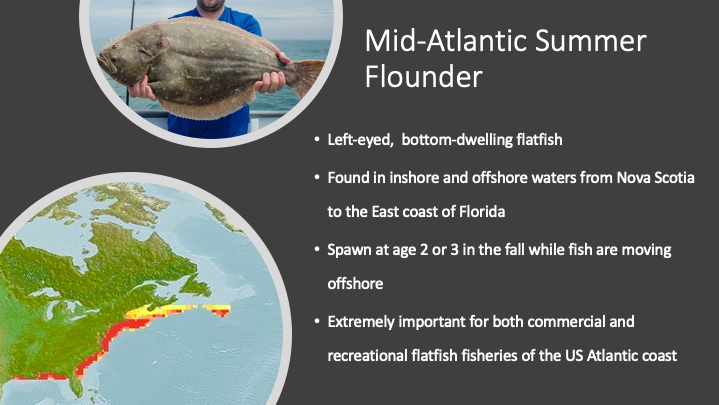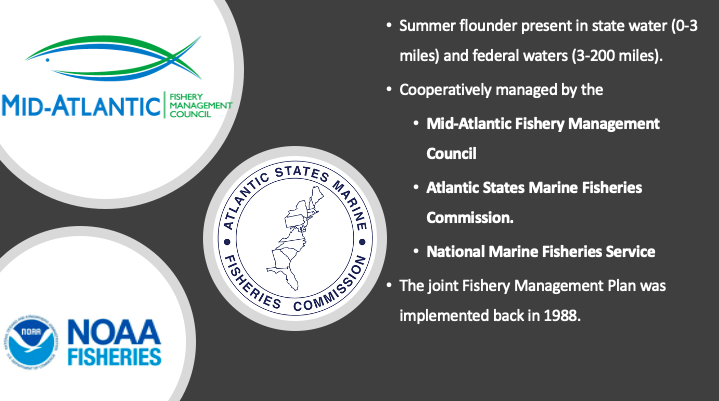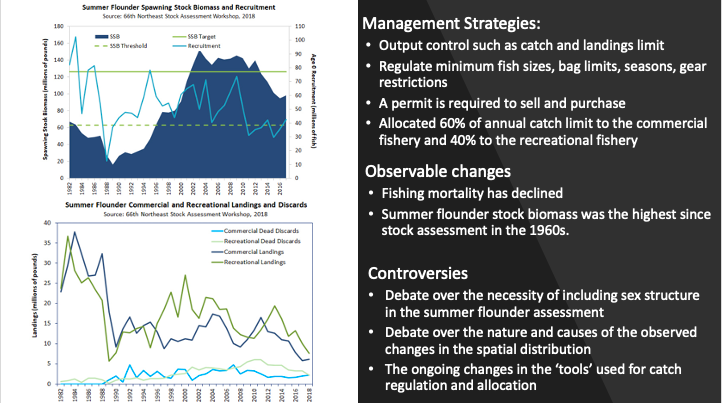This page is dedicated to the fishery management success for Mid-Atlantic Summer flounder. Summer flounder, also known as fluke, is a left-eyed, bottom-dwelling flatfish found in inshore and offshore waters from Nova Scotia to the east coast of Florida. In the US, they are most abundant in the Mid-Atlantic region from Massachusetts to North Carolina.
Summer flounder is the most important commercial flatfish species, in terms of weight and value landed. Large scale exploitation of summer flounder began around 1920. By 1940, commercial landings of summer flounder had reached 4,900 tonne and landings were consistently between 9,000 and 10,000 tonne during 1952–1961. Summer flounder is also important in recreational fishing, as they have historically been highly popular among sport fishermen, especially in New York and New Jersey waters.

Because of their presence in both state waters and federal waters, summer flounder is managed cooperatively by a few different organizations. They are the Mid-Atlantic Fishery Management Council and the Atlantic States Marine Fisheries Commission. The two management councils work in conjunction with the National Marine Fisheries Service (NMFS) for federal implementation and enforcement. The Fishery Management Plan (FMP) that came out of the cooperation was implemented back in 1988, when the poor status of the summer flounder stock was evident to scientists, managers, and fishermen. After the original fishery management plan in 1988, there has been over 21 amendments and 16 frameworks established to modify policy as changes in stock sizes are observed.

The Summer flounder fishery management plan (FMP) uses output controls as primary management tool, with landings divided between the commercial and recreational fisheries. They allocate 60 percent of the annual catch limit to the commercial fishery and 40 percent to the recreational fishery. The FMP also includes minimum fish sizes, which will protect juvenile fish and help to maintain the part of the population that is able to reproduce. There is also bag limits, seasons, gear restrictions, permit requirement and other provisions to prevent overfishing and ensure sustainability of the fisheries. The commercial quota is divided into state-by-state quotas based on historical landings. The plan also indicates that scientific data on the summer flounder resource and fishery will help determine how much summer flounder can be harvested the following year.
Studies have shown that by 2010, the fishing mortality on summer flounder had declined to its lowest level in at least 30 years, and the summer founder stock biomass was the highest since the stock assessment began in the 1960s. As we can see on these two graphs, the trend for landings and death discards is negative over the years. We also see the spawning stock biomass go through a drasic increase since 1982.

Of course, the management plan and summer flounder population are not without controversies. For instance, there has been a debate over the nature and causes of the observed changes in the spatial distribution of summer flounder and potential impacts for science and management. There has also been error in the assessment modeling results affecting the evaluation of stock status and the reliability of catch forecasts. Moreover, the scientific and political debate over the necessity of including sex structure in the summer flounder assessment. Mark Terceiro, fisheries biologist at Northeast Fisheries Science Center, published 3 papers about summer flounder assessment, all in different time periods so the comparison of population at different times was helpful.
 icons at the top right corner of the subsection.
icons at the top right corner of the subsection.